
July 2020
Millions Take the Streets in Upheaval Against Cop Murder Machine
To Uproot Racist
Oppression:
Socialist
Revolution
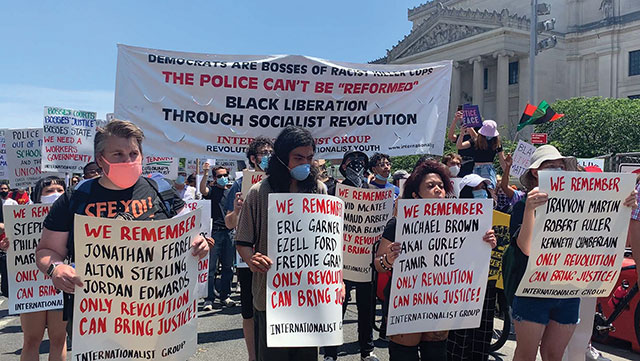
Revolutionary contingent in Juneteenth (June 19) march in Brooklyn. (Internationalist photo)
JULY 10 – The wanton murder of George Floyd by a cop in Minneapolis on May 25 set off a wave of outrage that swept across the United States and has continued for weeks. Day after day, night after night, millions of people took to the streets to denounce the racist police murder of black people that has continued unabated for decades. This massive upheaval against racist cop brutality was met by more police brutality, as gangs of cops slammed protesters to the ground, tear-gassed and pepper-sprayed them in the face, fired rubber bullets and bean bag rounds at them and drove police vehicles into crowds. More than 15,000 people have been arrested. Meanwhile, the cop murder machine grinds on: as of July 7, some 1,130 civilians have been killed by police in 2020, 285 of them since George Floyd was slain.1
On that day in May and since, millions of people viewed in horror a bystander’s video of racist cop Derek Chauvin digging his knee into George Floyd’s neck until his victim was dead. The cop’s smug demeanor, as he ignored voices crying out that he was killing Floyd, reeked of impunity. Floyd’s gasping pleas of “I can’t breathe” were a haunting reminder of the last words of another black man, Eric Garner, strangled to death by a New York City cop in 2014. For anyone with any degree of political awareness, this was proof positive that nothing had changed since the 2014-15 Black Lives Matter protests over the police murders of Garner, Michael Brown, Freddie Gray and so many others. Minneapolis exploded in rage, and in the following hours and days, so did the rest of the country.
Thousands of protesters converged on south Minneapolis, first on the corner where Floyd was killed, then at the 3rd Precinct where Chauvin and his three accomplices worked. In the next days, crowds surged through downtown, later marching on the state capitol in St. Paul. On the third night, demonstrators besieged the precinct, notorious for brutal cops who routinely pistol-whipped black and brown suspects, kicked them in the face and performed anal searches in the station.2 Until that night, the police had holed up in the station, firing tear gas and rubber bullets into the largely peaceful protesters outside.3 So it was no surprise when on May 28, as the cops fled the growing crowd, crashing through a gate to escape in a motorcade, the hated 3rd Precinct went up in flames as hundreds cheered.
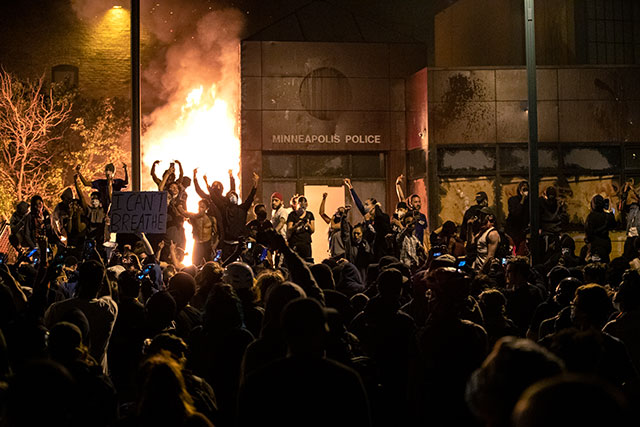
Hundreds cheer in Minneapolis as hated 3rd Precinct goes up in flames after cops flee on the night of June 28.
(Photo: Carlos Gonzalez / Star Tribune)
As protests spread across the country, clashes were provoked by cops geared up for battle who attacked demonstrators. Photos and videos flashed around the world of police cars trashed and torched, from Seattle and Los Angeles to Atlanta and New York and elsewhere. Democratic mayors and media screamed about “looting” to justify “law-and-order” crackdowns, imposing racist curfews and occupying cities with the National Guard. The incendiary racist provocateur president Donald Trump tweeted, “When the looting starts, the shooting starts,” and brought thousands of National Guard troops and the elite Immediate Response Force of the 82nd Airborne Division to the Washington, D.C., area.4 The police-state measures were then used almost exclusively to suppress peaceful demonstrations.
As for some youths grabbing stuff from fancy stores they could never afford to shop in, to paraphrase the German communist playwright Bertolt Brecht, what is the “crime” of looting Macy’s compared to the crime of owning it?5
Despite efforts to discredit the protests, people weren’t buying it. Public opinion polls which up to 2018 showed more opposition than support to the Black Lives Matter movement showed more than two-thirds support by early June, including 60% among whites, a striking figure given the history of this racist country. Now 76% of the overall population (and 71% of white people) called racism and discrimination a “big problem,” 78% said protesters’ anger is fully or somewhat justified and a majority of whites (54%) said police are more likely to use deadly force against black people. Even when primed for a negative response, asked if they are aware of protests across the U.S. “including the burning of a police precinct in Minneapolis” in response to the police killing of a black man, 54% said they thought “the actions of the protesters” were fully or partially justified (Monmouth poll, 2 June).6
Biggest Sustained Protests in U.S. History
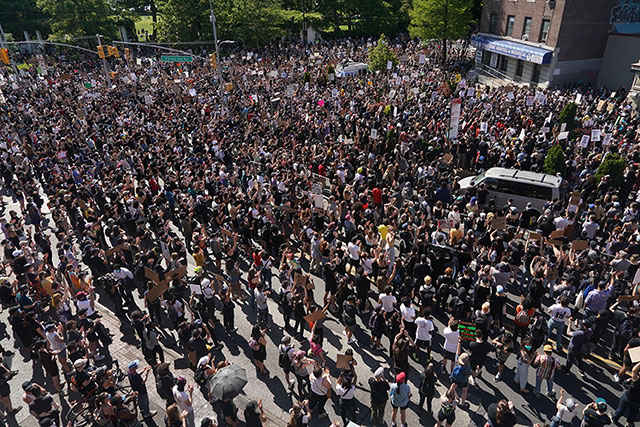
Demonstration for George Floyd in Brooklyn, May 30. Massive Black Lives Matter protests erupted across the U.S. Click on photo for larger size. (Photo: Chang W. Lee / The New York Times)
In the last few weeks, the U.S. has been going through a catharsis over the deeply ingrained racism of American society. The murder of George Floyd and the subsequent brutal repression of protests brought to a head a “seismic change” in white opinion on race which has been building for some time, particularly but not only concerning the police. As Trump dug in deeper, this change registered among Democratic pols: after earlier telling demonstrators to go home to avoid coronavirus infection (and defending the actions of the police under their command), they now switched gears and gave a stamp of approval to the protests while seeking to coopt them with phony “reforms” to move some funds from police budgets to social services. The liberal Democrats were aided in this cynical con game by reformist leftists who eagerly organized rallies and marches on the slogan of “defund the police.”
Partly as a result of this shift in strategy by a section of the capitalist rulers, as well as due to anger at Trump’s racist pyrotechnics and the cops’ brutal attacks on protesters, Black Lives Matter demonstrations grew even larger. On June 6, there were 550 protests reported across the country, bringing out over 100,000 in Washington, D.C. and perhaps 80,000 in Philadelphia. In NYC in mid-June there were a dozen marches a day of upwards of 1,000 demonstrators each. Adding it up, the New York Times (3 July) counted at least 4,700 demonstrations, or about 140 a day, in 2,500 cities and towns over the last five weeks. “Black Lives Matter May Be the Largest Movement in U.S. History,” it headlined, citing figures from polls showing that 9 to 10% of the entire population, or 23 to 26 million people, had joined in protesting. That’s huge.
The current protests have been described as “more integrated” than the BLM marches of 2014-15. This is not entirely accurate: in the major cities, the protests in that earlier period were racially and ethnically integrated, with tens of thousands of black, white, Latino and Asian marchers. What is true is that in recent demos there are far more white protesters. There is also a noticeable political difference: while five years ago the marches were seen (and many marchers saw themselves) as “radical” in some sense, today there are large numbers of mainstream liberals. Those liberals have become convinced that there is “systemic racism” in the U.S., which we as Marxists have always insisted is a bedrock truth about American capitalism. But their demands, taken up by pseudo-socialists who want to nudge them slightly to the left, have not transcended the limits of bourgeois politics. Thus they cannot get to the root of the murderous racist actions of the police.
The giant, and truly unprecedented, marches across the United States against murderous police repression have reverberated around the world. Media images of flaming police cars have led many impressionistic leftists, both here and elsewhere, to imagine that the U.S. is suddenly, seemingly out of nowhere, in the throes of a revolutionary uprising. This is far from being the case. The same opportunist leftists talked of a pre-revolutionary situation in France in 2018-19 with the explosion of the “yellow vests” movement, touched off by a rise in gasoline prices. They saw the same in the original BLM protests that shut down highways across the U.S. They waxed lyrical about the Occupy Wall Street movement against inequality in 2011. Earlier that year, they hailed “revolutions” in the Arab world – as did Western imperialists.
But starry-eyed make-believe, and what Lenin decried as “tailing” existing consciousness, does no one any good, and certainly not those who seriously seek to overthrow the system that, day in and day out, produces murderous racist repression. In none of these instances have there been genuine revolutions, nor have they produced real advances for the exploited and oppressed. Whether populist movements, spontaneous explosions of the downtrodden or liberal appeals for reforms, they did not challenge the capitalist system which produces untold misery – from obscene inequality to mass unemployment to racist repression – nor were they based on mobilizations of the power of the working class that produces the capitalists’ wealth. So, despite the widespread outrage they tapped into, they failed, even in their own terms. Yet the combustible material that can fuel a revolution is everywhere. What’s urgently needed is revolutionary leadership.
At the present time in the United States, there is a conjunction of deep crises. There is the deadly coronavirus plague: 135,000 dead so far. There is skyrocketing unemployment: more than 50 million people made jobless in a few weeks. There is the never-ending scourge of cops killing people: more than 1,700 a year since 2014, over 28,000 since 1 January 2000. And these crises are intimately related. The horrific death toll of COVID-19 is the result of the chaotic response of capitalist governments that endanger the lives of those they govern. The mass unemployment is the result of the government-ordered shutdown of the economy, from which – under what Karl Marx called capitalism’s “anarchy of production” – it will take years to recover. And the murderous police repression reflects the racist oppression that, as we have written, is in the DNA of U.S. capitalism. Only a socialist revolution can end these plagues.
Operation “Defund the Police”
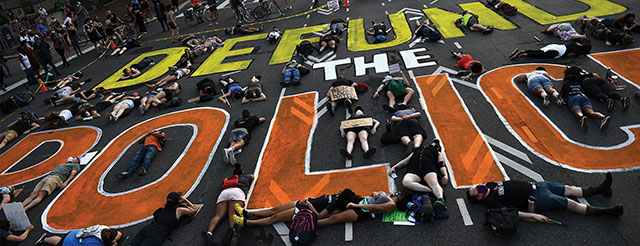
Demonstration in Washington, D.C., calls to “Defund the Police,” June 2020. (Photo: Brendan Smialowski / AFP)
For the past five weeks, one of the main slogans that has been raised in protests across the country is “defund the police.” This strikes terror into the hearts of conservative Republicans, flummoxes mainstream Democrats, and excites liberals as well as reformist leftists. It is a vague demand, leading to myriad articles about what defunding the police “really means.” On the face of it, it’s a rather strange slogan, focusing on money when the demonstrations have been against racist police brutality. It has a kind of NGOish quality, which is not surprising as it originated with a Twin Cities non-governmental organization, Black Visions Collective, which on May 25, the same day George Floyd was murdered, launched a petition titled “Tell Minneapolis City Council to Defund the Police.”7 The call instantly spread around the country.
It’s no accident that the demand arose in one of the most liberal cities in the United States, with two black trans city council members, and a mayor and a majority of the city council elected on programs to reform the Minneapolis Police Department, even as the cops keep on brutalizing and killing African American, Latino and Native American people. Several local foundation-funded non-profits have been calling to downsize or replace the police force, among them MPD150, which describes itself as “working toward a police free Minneapolis.” “Dismantling the police will require reallocating their budget,” it states, calling to “sequester” the MPD’s military equipment, to transfer “first responder responsibility” to community-based social services and generally to “transform the way policing, crime and safety are understood in Minneapolis.”
Far from being a program for red revolution from fire-breathing radicals, as right-wingers claim, this is a utopian liberal “reimagining” of a “people-friendly” capitalist urban America. Within days of Floyd’s murder, a majority of the Minneapolis city council read a pledge before a crowd in a city park to “dismantle the police” and replace it with a new system of public safety. The crowd responded “Defund the MPD!” And on June 26, the council – all Democratic-Farmer-Labor (DFL, the Minnesota branch of the Democratic Party) except for a lone Green – voted unanimously for a city charter amendment to replace the MPD with a Department of Community Safety and Violence Prevention, under which a Division of Law Enforcement Services would be “composed of licensed peace officers, subject to the supervision of the department of community safety and violence prevention.”
In Minneapolis, virtually every one of the police “reforms” that have been bandied about in the U.S. have been tried, and failed. A civilian police review board? Minneapolis has had one since 1990. Police body cameras? They were instituted after the 2015 cop murder of Jamar Clark. Ditto for implicit bias training. Last year the city reduced the police budget and transferred funds to violence prevention programs. The MPD is now headed by a black police chief. Before that it had a lesbian Native American police chief. Since 2016 the MPD has had a “duty to intervene” regulation requiring officers to stop another officer from using excessive force, and it no longer taught chokeholds and neck restraints. But none of that stopped killer cop Chauvin, aided by his fellow officers, from killing George Floyd.
Cancel laws shielding police disciplinary records (as New York’s 50-A law does)? Minnesota doesn’t have one, so it was soon reported that Chauvin had been involved in several police shootings and had ten complaints of abuse filed against him – all to no avail. De-escalation? Minneapolis banned fear-based “warrior-style training,” but the police “union” offered it for free. “Disarm/demilitarize the police”? George Floyd’s killer used his knee, the New York cop who murdered Eric Garner used his bare hands. Community-based patrols? Trayvon Martin was killed by a community watch member in Florida. In Latin America, some left groups call for electing police chiefs. Yet the racist sheriff of Maricopa County, Arizona, Joe Arpaio, who held thousands of immigrant detainees in a tent city concentration camp in 110°+ heat, was elected five times.
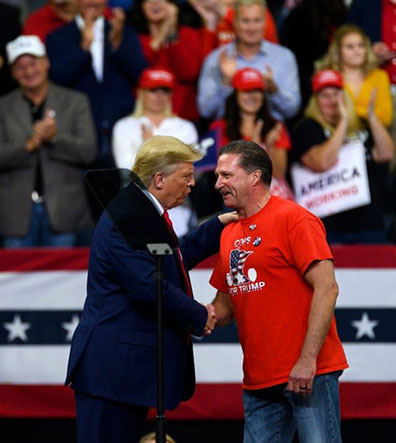 Fascistic Minneapolis
police “union” chief Bob Kroll greeted by Donald Trump at
October 2019 campaign rally in Minneapolis .
Fascistic Minneapolis
police “union” chief Bob Kroll greeted by Donald Trump at
October 2019 campaign rally in Minneapolis . (Photo: Stephen Maturen/Getty Images )
It makes little difference if cops are called “peace officers” instead of police (Minnesota state police are officially peace officers), or if the “law enforcement” agency is now a department of public safety (as in Mexico, with its notoriously brutal police). It is possible that in Minneapolis, with its fascistic police “union” chief Bob Kroll (who sports a “white power” patch on his motorcycle jacket), a thorough purge could reduce wanton police violence somewhat. But at bottom, the reason that none of the numerous proposals to “reform” the police have ever succeeded is that racist and anti-working-class repression is the essential function of the police.
Arising from runaway slave-catching patrols in the pre-Civil War South, professional uniformed forces were formed in city after city across the country to keep down the poor, break strikes and impose the rulers’ “law and order.” Racist cop terror is endemic and systemic because the very purpose of “policing” is not to “serve and protect” the population, but to uphold the rule, property and profits of the owning class in this capitalist society, whose staggering inequalities took shape under slavery and whose continued domination has always rested in large part on racial oppression.
Democrats Are Still the Bosses of the Racist Killer Cops
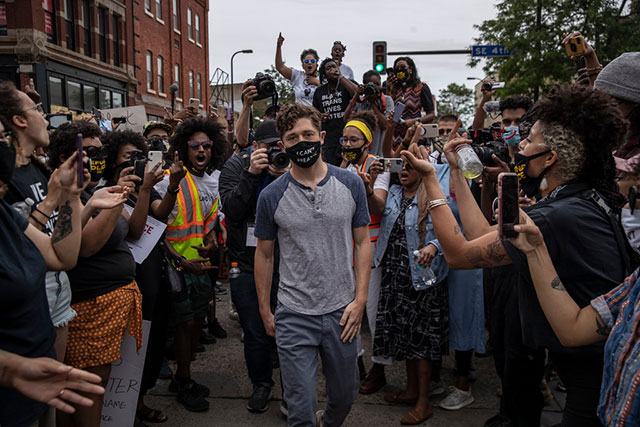
Minneapolis mayor Jacob Frey booed out of demonstration for George Floyd. City council voted to "dismantle" the police, only to replace it with a “Department of Community Safety and Violence Prevention.” (Photo: Victor J. Blue for The New York Times)
The call to “defund the police” has become so widespread precisely due to its ambiguity. It can be interpreted to mean anything from Democratic House of Representatives Speaker Nancy Pelosi’s “shuffle some money around” to the Minneapolis DFLers’ vow to “dismantle” the MPD. Some Democratic mayors like New York’s Bill de Blasio and Minneapolis’ Jacob Frey were jeered and run out of demonstrations for George Floyd for opposing calls to defund the police. Black Democratic mayors of Chicago (Lori Lightfoot) and Washington, D.C. (Muriel Bowser) still oppose calls to shrink the police, while Atlanta mayor Keisha Bottoms claims she already did it. But under pressure, most mayors decided to at least trim police budgets a bit. Bowser covered herself by painting a giant “BLACK LIVES MATTER” on 16th Avenue near the White House.
De Blasio has now done the same on Fifth Avenue in front of Trump Tower. (Trump tweeted in response that “Black Lives Matter” is a “symbol of hate,” which would “denigrat[e] this luxury avenue.”) The inveterately two-faced New York mayor, after being booed off the stage at Cadman Plaza in Brooklyn on June 4, negotiated a budget with the city council which he claimed cut $1 billion from the NYPD’s $6 billion budget. It’s all smoke and mirrors: almost half the amount is from shifting the budget line for school “safety agents” to the Department of Education, and most of the rest comes from attrition through retirement. The actual police budget is $11 billion, NYC will still have an army of 38,000 cops (plus 20,000 other NYPD employees), and within months new cadets will be brought in, even as there is a hiring freeze for teachers, hospitals and all other city departments.
Beyond such bait-and-switch gimmicks, the Democrats face a huge problem. With millions in the streets demanding an end to racist police brutality, despite all of the ambiguity and wiggle room to interpret “defund the police,” their presidential candidate in November, Joe Biden, flatly declared that “I do not support defunding the police” (USA Today, 10 June), and in fact wants to increase police funding. Biden wrote Bill Clinton’s 1994 Violent Crime Control and Law Enforcement Act, which he bragged led to the hiring of “100,000 cops” and “125,000 new state prison cells,” greatly increasing the numbers of African Americans behind bars. When Trump called to shoot looters, Biden responded by suggesting that police officers “shoot them in the leg.” Throughout his political career, Biden has kept close ties with police “unions.”
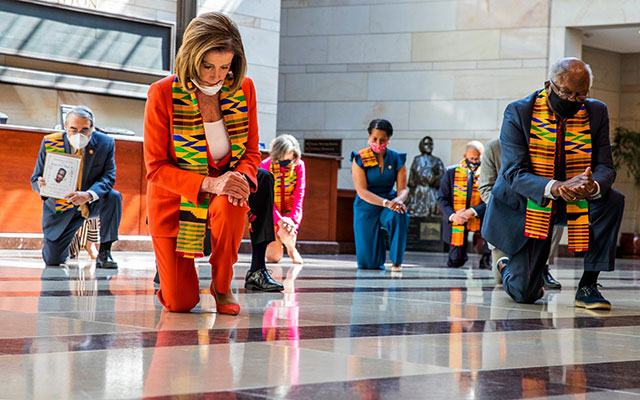
Congressional Democrats, led by House speaker Nancy Pelosi, hypocritically kneel in African kente cloth, 8 June 2020. House Democrats’ “George Floyd Justice in Policing Act,” provides more money for police. (Photo: Manuel Balce Ceneta / AP)
Likewise, Biden’s former primary rival, Bernie Sanders, when asked about “defunding or abolishing the police,” declared that he opposes getting rid of police departments. Now stumping for Biden, the self-proclaimed “democratic socialist” also voted for the 1994 Clinton crime bill. Absurdly claiming that cops are low-paid (the average NYC police officer’s base pay is $77,000, before overtime), he called for more resources to pay higher “wages that will attract top tier” professionals to the police. In addition to hiring top-dollar cops, Sanders has also proposed a “civilian corps of unarmed first responders to supplement law enforcement, such as social workers, EMTs, and trained mental health professionals, who can handle order maintenance violations, mental health emergencies, and low-level conflicts to aid police officers.” This would turn medical and social service providers into auxiliary cops.
These reactionary proposals have now been included in the “Biden-Sanders Unity Task Force” (July 8) recommendations on “Reforming Our Criminal Justice System,” along with calls to “reinvigorate community policing” – i.e., to put more police into already cop-infested neighborhoods. When this approach was used in Rio de Janeiro, Brazil, with the formation of Police Pacification Units, it led to a sharp increase in police killings.8 Then there is the Democrats’ “George Floyd Justice in Policing Act,” passed by the U.S. House of Representatives last month (although D.O.A. in the Republican-controlled Senate), which calls for $750 million for “independent investigations” of police use of force. This would include having one law enforcement agency investigate another. So the Nassau County police could investigate the NYPD? Police investigating police? No thanks.
Malcolm X: “You Can’t Have Capitalism Without Racism”
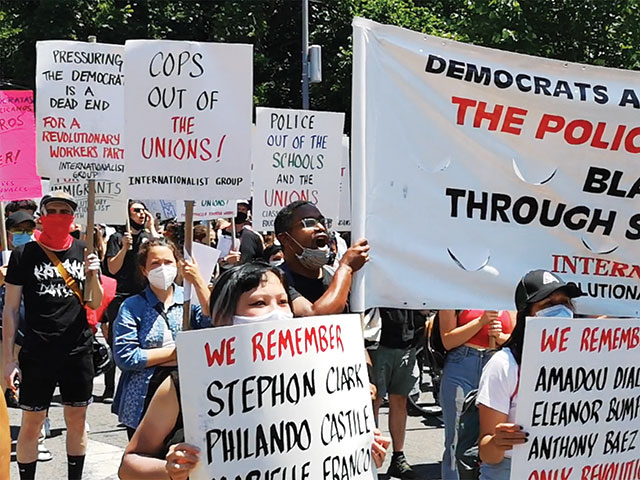
Internationalists say: Cops out of the unions and out of the schools, pressuring the Democrats is a dead end, for a revolutionary workers party. (Internationalist photo)
Demands to “defund the police” are invariably combined with calls to instead use the money to pay for social services, and often linked to appeals to “tax the rich.” Like calls for “books not bombs,” “money for schools, not for war” and the like, they are posed as if it’s a choice of budget priorities. This is a reformist illusion that echoes the timeworn deceptions of liberal bourgeois politics, which by hoodwinking the masses helps maintain the system of racist oppression and exploitation. U.S. rulers don’t go to war because their government has decided that’s the best way to spend the money they have bilked out of working people in taxes. The U.S. invades country after country (Afghanistan, Iraq, Syria lately; before that Vietnam, Korea, Cuba…), and the Pentagon maintains hundreds of military bases (officially 600) in 80 countries, in order to impose its global hegemony. This is an existential question for U.S. imperialism, even more so in the 21st century when it must rely more on military might than its fraying economic dominance.
Likewise, the attack on public education and the militarization of the police, armed with heavy weaponry and trained for urban combat, are not a question of spending “priorities.” As capitalism decays, the ruling class (with its politicians, Republicans and Democrats alike) want to gut public education, to turn it into a source of profits and steady cash flow for the bourgeoisie to offset the declining rate of profit. At the same time, inequality soars, and along with it growing poverty, depression-level unemployment and a housing crisis driven by real estate speculation that has sent rents and house prices soaring even as 17 million housing units stand vacant in the U.S. Thus the capitalist rulers – and not just in the U.S. – have concluded that they need paramilitary police forces to suppress potential revolts (“domestic disturbances”) by their impoverished subjects, which they can already see are in the cards.
While pseudo-socialists talk of funding this or that and talk blithely of “abolishing” the police, revolutionary Marxists insist that the police are a central pillar of the state. As Friedrich Engels wrote 136 years ago in The Origin of the Family, Private Property and the State, the state is an instrument of class rule, for the subjugation of the exploited by the exploiters, and consists of “armed men but also of material adjuncts, prisons, and institutions of coercion of all kinds.” Lenin added, in his work The State and Revolution, written in preparation for the 1917 October Revolution, “A standing army and police are the chief instruments of state power.” This is not an abstract formula. It means concretely that capitalist rule cannot exist without police, and the police cannot be “abolished” without overthrowing the capitalist state.9
The police are the guard dogs of capital, although they may slip the leash at times and fascistic elements chafe at civilian control. Fundamentally, the police impose the racist “law and order” of American capitalism, which was forged on the genocide of the Native American peoples and the chattel slavery of Africans brought here in chains, and which to this day is based on racist oppression. As Malcolm X insisted, “You can’t have capitalism without racism.” The particularly murderous role of the police in the United States, along with other institutions such as the barbaric death penalty, are proof positive that despite the abolition of slavery in the Civil War of the 1860s, its heritage lives on in the 21st century.
For all the Obama-era happy talk of a “post-racial” society, the brutal reality of racist capitalism is revealed by a knee to the neck, by a stranglehold, by trigger-happy cops with Glocks. As Michelle Alexander has documented in The New Jim Crow: Mass Incarceration in the Age of Colorblindness (2010), just as after the abolition of slavery in the Civil War the racist rulers responded with KKK terror and Jim Crow segregation to deny black people their rights, so following the passage of the 1960s civil rights laws, a new system of control came about, particularly through the “war on drugs.” Today 2.3 million people are imprisoned, two-thirds of them black and brown, the highest proportion of the population of any country on earth behind bars, plus another 4.5 million under the control of the racist “justice” system.
“Systemic Racism”: The System Is Capitalism
So now what began as protests against police brutality has become a broader struggle against racism. As statues to Confederate generals fall, aside from inveterate Trumpian racists, it is broadly admitted that there is “systemic racism.”10 But what is that system? Contrary to the rhetoric used by some liberals, reformists and nationalists, it is not “white people” in general who rule this system, it is capital – the owners of the factories, banks, communications and transport – that calls the shots. It is the racist capitalist system that produces massive poverty, unemployment, pervasive discrimination and violent repression of African Americans in particular, as well as of other specially oppressed sectors of society and working people overall. And to supplement the main force of violent repression, the bourgeois state, there are the white-supremacist fascist gangs brandishing AR-15 automatic rifles, itching to set off race war. (Some even tried to infiltrate the Black Lives Matter protests to stage provocations.)
As Marxists, we understand that racism is not just some toxic ideas floating around that can be rooted out by “bias training” or “checking privilege.” Rather, racist ideology grows out of and reinforces the material reality of the oppression of black people, which is an indelible birthmark of American capitalism. That is a reason we do not use the term “people of color,” because the oppression of African Americans is not identical with that of immigrants, for example (even as immigrants may today have even lower wages). Black people in the United States are oppressed as a race/color caste, segregated at the bottom of society, and no matter how many civil rights laws have been passed, no matter if there is a black president, black mayors or black police chiefs, for all the talk of “empowerment,” it is a question of real power, and as we fight racism and racist oppression every day, we have to tell the truth, that black oppression can’t be eliminated until capitalism is dead and gone.
Opportunist leftists see the present politically liberal protests through rose-colored glasses because they place themselves on a continuum, just a step to the left of the liberals. Today even many liberals understand that the institution of the police, “as we know it,” is inherently racist. But the reformists and centrists obscure the class line, and with their “fight the right” politics they constantly cross that line seeking political alliances with bourgeois liberal forces. As the German revolutionary Marxist Rosa Luxemburg wrote 120 years ago in her pamphlet, Reform or Revolution, denouncing the reformists of her day, they “do not really choose a more tranquil, calmer and slower road to the same goal, but a different goal. Instead of taking a stand for the establishment of a new society they take a stand for surface modifications of the old society.”
Yet in the present situation, with the rampant pathology of this decaying system laid bare, after over a month of mass mobilization large sections of the population have been jolted into political awareness. The fact that hundreds cheered as they watched a police station that was a nest of racist thugs burn down, that tens of thousands defied racist curfews and braved police attacks, that millions joined Black Lives Matter protests, however liberal their politics, suggests that among the youth and broader layers, loyalty to the system is beginning to crumble. As armed fascists mobilize and racist drivers plow into protesters, it has become “which side are you on?” And the terrible toll of the COVID-19 pandemic can open eyes of those willing to see that capitalism spells death and devastation on a vast scale.
Transitional Program for Socialist Revolution
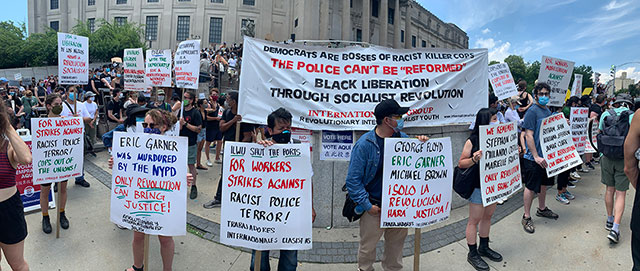
IG, Revolutionary Internationalist Youth, Trabajadores Internacionales Clasistas and Class Struggle Education Workers marched on Juneteenth, calling for workers strikes against cop terror, like the ILWU shutdown of all West Coast ports. Click on photo for larger size. (Internationalist photo)
A lot of the impact of these combined crises is only beginning to be felt. The effect of the unemployment of tens of millions of working people has been temporarily mitigated by $1,200 “stimulus” checks, the expansion of eligibility for unemployment insurance to include “gig economy” workers and the $600 per week supplemental benefits. But those measures, which Republicans would have denounced as socialism only a few months ago, are due to end soon. Young people are especially hard-hit, as over half (52%) of millennials have lost their jobs or seen their hours cut. In New York City, 1.25 million jobs have been lost, producing an effective unemployment rate of 26%. Now a tidal wave of evictions is expected, as large numbers of tenants have been unable to pay their rent (up to 40% in NYC). It’s all coming together, soon.
While the opportunist leftists, as always, chase after the “mass movement,” the task of revolutionaries is to provide leadership for struggle. These are the kind of conditions in which Leon Trotsky’s Transitional Program has particular relevance, to provide a “bridge between present demands and the socialist program of the revolution.” In the face of mass unemployment, the call for a sliding scale of wages and hours, for a radically shorter workweek with no loss in income, to provide jobs for all, should be taken up everywhere. There should be a huge expansion of public housing, as well as occupying vacant buildings and hotels, to provide housing for all, and a vast program of school construction and hiring of educators to sharply reduce class sizes. In the workplace, workers health and safety committees should be formed, which would shut down unsafe operations. This could spark a struggle for workers control, that is, dual power at the point of production, contesting the bosses’ power on the road to revolution.
Such measures point toward what a socialized, planned economy based on production to fill social needs rather than private profit would do, and thus to the need to overthrow capitalism. But when it comes to the police and other repressive organs – courts, jails and military – as the failure of every purported reform of the misnamed “justice system” shows, the ruling class is dead-set against any weakening of the central core of state power, which Democrats and Republicans alike are constantly fortifying. Demands here would include:
- for labor/black/immigrant mobilization against racist attacks and to stop deportations;
- for worker/community mobilization to stop evictions;
- for workers strikes against racist cop terror, as the ILWU dock workers did on Juneteenth, shutting down every West Coast port;
- for the right of black armed self-defense, and
- for workers defense guards mobilizing the power of the multiracial/multiethnic working class.
The Internationalist Group has called for, and where possible sought to realize, such measures for the class mobilization of the working people and the oppressed. This also requires a fight within the labor movement to oust the pro-capitalist bureaucracy which has undermined workers’ struggles and chained the mass organizations of the working class to the parties and politicians of the ruling class. Thus, while class-struggle unionists seek to oust the police from the unions, as the League for the Fourth International has fought for and, uniquely on the left, carried out,11 the top union officialdom has fought to keep these armed enforcers of the class enemy inside labor’s house. Labor militants must fight to oust the bureaucrats, break with the Democrats and build a revolutionary workers party!
As workers’ strikes have broken out amid the pandemic, from fruit packinghouse workers in Yakima, Washington, to shipbuilders in Bath, Maine, the Trotskyists of the IG have sought to build solidarity and intersect these struggles with our revolutionary program. As Karl Marx pointed out long ago, every real class struggle is a political struggle. In the present juncture, the economic and social crises of decaying capitalism intersect deep divisions in the ruling class, as witnessed in the failed impeachment of Donald Trump. Today Biden, Sanders and their lieutenants are desperate to channel protests against police brutality into votes for the Democrats, “the bosses of the racist killer cops.” And at the same time as Trump stages military provocations in the South China Sea, the Democrats are the biggest China-bashing warhawks of all.
The fight against racist repression “at home” is inseparable from the fight against imperialist aggression abroad. Here, too, the contrast between revolutionary-internationalist and reformist politics is stark: the would-be socialists who join with bourgeois liberals in calling to “defund the police,” thus helping the Democrats peddle illusions that the capitalist state can be reformed, at the same time regurgitate the imperialists’ anti-communist war propaganda over Hong Kong, China and North Korea – also fueling anti-Asian racism.12 To eradicate racist oppression, to pull it out by the roots, and to end imperialist marauding, nothing short of the overthrow of capitalism will do the job. That is why it is crucial to build a revolutionary vanguard that fights the ruling class down the line, in the struggle for socialist revolution, here and throughout the world.■
- 1. See ongoing tally at https://fatalencounters.org/
- 2.“Minneapolis’ Third Precinct Served as ‘Playground’ for Renegade Cops,” Star Tribune, 7 June.
- 3. “‘The precinct is on fire’: What Happened at Minneapolis’ 3rd Precinct – and What It Means,” American Public Media Reports, 30 June.
- 4. See “Trump and Democrats Stage Ominous Trial Run for Martial Law,” The Internationalist, June 2020.
- 5. Macy’s is notorious for its racist practices of accusing black shoppers and visitors of shoplifting and then holding them in its private jail on the premises. See the Class Struggle Education Workers pamphlet Campus Protest, Capitalist “Security” and the Program of Class Struggle (2014), Part 2, “From Slave Patrols and Pinkertons to Private Jails for ‘Shopping While Black’.”
- 6. Even after Trump’s hysterical attempts to whip up a backlash, a late-June Monmouth poll released on July 8 showed 67% saying that racism and discrimination are a big problem.
- 7. “How ‘Defund the Police’ Went from Moonshot to Mainstream,” Politico, 17 June.
- 8. See “Racist Execution in Rio,” The Internationalist No. 51, March-April 2018.
- 9. Interestingly, in view of current proposals to rebrand the police, in the German text, Engels refers not to police but to a “public force,” a term used today in many countries (fuerza pública, force publique, etc.). That is, they don’t have to be called police to be police.
- 10. At the high point of the protests, the Merriam-Webster dictionary announced that it was rewriting the definition of racism to include systemic racism.
- 11. Read about how our Brazilian comrades fought to oust the police from the municipal workers union in Brazil’s “steel city,” and the state repression unleashed against them, in our Dossier: Class Struggle and Repression in Volta Redonda, Brazil (1997)
- 12. See “Hong Kong ‘Democracy’ Riots: Pro-Imperialist, Anti-Communist, Fascist-Infested,” in The Internationalist No. 58, Winter 2020; and “Hong Kong: Defeat Pro-Imperialist Riots With Revolutionary Workers Mobilization,” in The Internationalist No. 57, September-October 2019.
